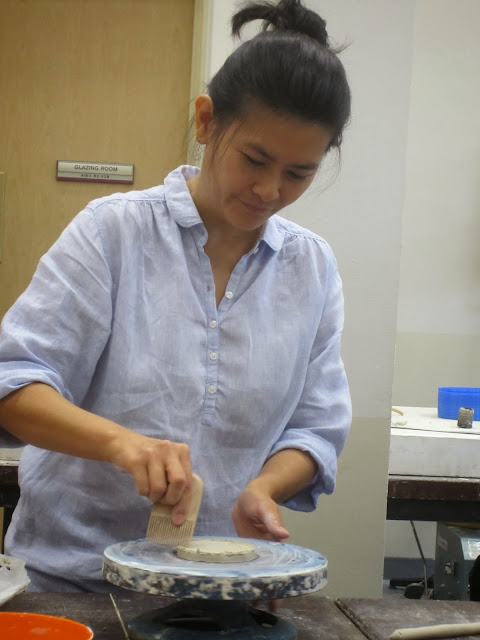this lesson is on texture
homework for the previous week was to make 10 'visual texture' by rubbing white paper; acrylic paper/glass paper/mahjong paper/ computer paper/drawing block paper against rough surfaces.
out of the ten, only these 7 were slightly more unique
1. metal drain cover in nie
2. Miss Seck's bamboo weave basket
3. the fan at home
4. keyboard in printmaking room
5. the back of the cardboard
6. the rough wall of nie
7. The tiles in my kitchen
anyway, there are surface texture vs relief texture.
surface texture are those above... still 2D and flat but 'show' roughness...
Intaglio is another form of surface texture and in certain cases, it can be recovered with a gentle rub. ie; scratching the surface of the skin with long fingernails... eeewww...
there are high vs low relief texture.
low one could be that of a coin surface whereas high one refer to those with a form popping out but still attached to a flat surface
as for the day's lesson was to create 5 physical texture using gypsum on plywood....
homework for the previous week was to make 10 'visual texture' by rubbing white paper; acrylic paper/glass paper/mahjong paper/ computer paper/drawing block paper against rough surfaces.
out of the ten, only these 7 were slightly more unique
1. metal drain cover in nie
2. Miss Seck's bamboo weave basket
3. the fan at home
4. keyboard in printmaking room
5. the back of the cardboard
6. the rough wall of nie
7. The tiles in my kitchen
anyway, there are surface texture vs relief texture.
surface texture are those above... still 2D and flat but 'show' roughness...
Intaglio is another form of surface texture and in certain cases, it can be recovered with a gentle rub. ie; scratching the surface of the skin with long fingernails... eeewww...
there are high vs low relief texture.
low one could be that of a coin surface whereas high one refer to those with a form popping out but still attached to a flat surface
as for the day's lesson was to create 5 physical texture using gypsum on plywood....
we were given 5 pieces of single ply plywood each which were cut, with a penknife, out from a 4m by 8m piece that cost approx $4... even cheaper than some of the art paper i buy la... =S
However, it warped after absorbing the moisture from the gypsum that was layered on it..... alternative was to use the multi ply plywood... do be careful of splinters while cutting it though...
a big big pail of 28kg only cost about $30 and they do come in smaller qty too ... click here to order
do the mixing on wax magazine pages to avoid the headache of having to wash.... the knife can either be replaced by disposable knife or ice-cream stick too....
one mega like about david's class is that he gave superb idea on how to minimise the cleaning up after an art lesson which is so very de important for the conduct of primary school art lesson that's less than an hour per week ... =S...
3 of my creations which are look-able and display-able according to my standard... =P
my lollipop flower
white ferry in the Atlantic ice
for outdoor display:
- seal plywood with emulsion paint
- apply wood vanish/ thinner/turpentine over completed work
~~~~~~~~~~~~~~~~~~~~~~~~~~~~~~~~~~~~~~~~~~~~~~~~~~~~~~~~~~~~~~~~~~~~~~~~~~~~~~~~~~~~~~~~~~~~~~~~~~~~~~~~~~~~~~~~~~~~~~~~~~~~~~~~~~~~~~~~~~~~~~~~~~
wonderful classmates' work that i like
Ocean wave
what big nose u have???
pretty pretty flowers
rooftop of peanut butter tiles
leather??? croc skin??
luv the sweet colours
ending the post with a fun shot of our table during the class....
this was the blue thingy that angeles was "feeding" me.... doesn't it look like the cream flowers on cake???? too bad, it's gypsum .... =S
more contacts from david for future art shopping spree... =) ... really hope they have e-billing though...
Acrylic sheets, very good for customization
Industrial stuffs, the alternative is your nearby neighborhood shops
Uber power website for all arty things
http://www.artvark.com.sg/
~~~~~~~~~~~~~~~~~~~~~~~~~~~~~~~~~~~~~~~~~~~~~~~~~~~~~~~~~~~~~~~~~~~~~~~~~~~~~~~~~~~~~~~~~~~~~~~~
this is part 6 of 7 parts to the series "Advanced Diploma in Primary Art Education". A series of blog posts that are updated weekly (from aug - nov) to document the activities, progress and learning point(s) from the week's lessons... =)
Part 5 - IVP4405: Artistic Development of Children
Part 7 - IVP4407: Curriculum Development and Assessment

















































































